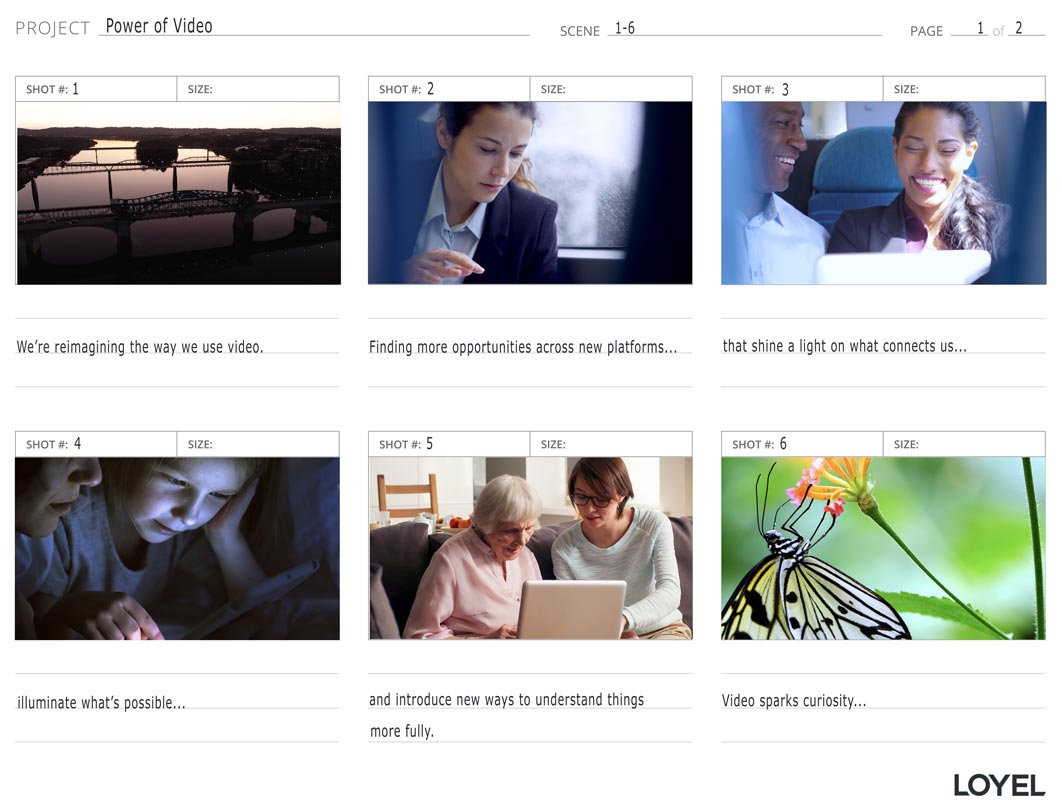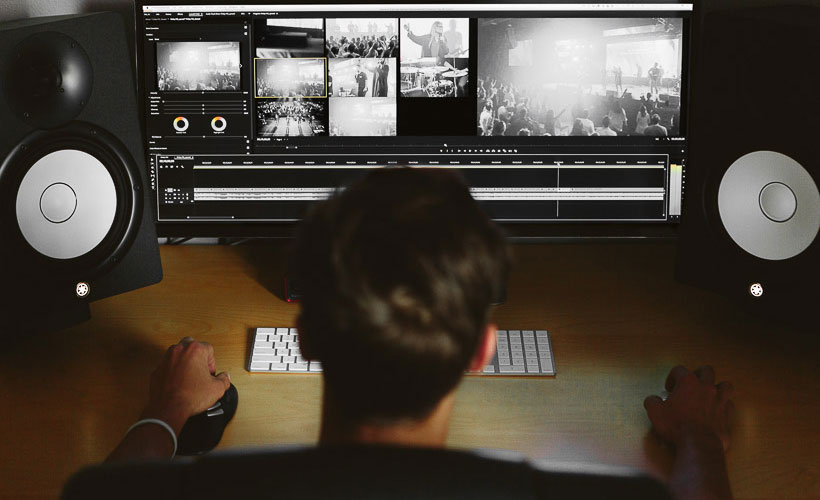Media professionals are pushing technology and stretching the capabilities of their tools to make videos more engaging and exciting. Having said that, the same tried-and-true steps for producing video content remain unchanged. Let’s take a look at the three essential stages of the video production process.
Today, video is not only a source of entertainment but also a learning tool, a conferencing channel, and a powerful marketing tool that you can use in multiple ways to engage consumers and add value to your company’s bottom line.

AUDIO: LISTEN TO THIS ARTICLE.
With video technology now at our fingertips and a captive audience just a click away, how we use video content in our everyday lives has been reimagined.
In this article, we’ll look at the process media professionals use to produce video content. Whether you’re outsourcing your video or overseeing an in-house project, you’ll walk away with a greater understanding of what you can expect throughout the video production process.
“Video production is the process of producing video content.”

Video production is probably similar to a number of projects you’ve worked on before. First, you plan your project. Then, you gather the parts to build it. Finally, you produce the work necessary to complete your project. The video production process utilizes the same method.
What are the Three Stages of the Video Production Process?
There are three principal stages included in the video production process:
- Pre-production
- Production
- Post-production
Each is critical to your video’s success. Even a simple video production with a single camera shoot will incorporate these three stages in its workflow.
Most companies do not staff in-house media crews to produce videos for their businesses. More often than not, they turn to freelancers or professional video production houses to create high-value video content to market their products and services. And of course, some companies do a little of both. They produce some video content in house and outsource some of their more high-quality content.
Business video content can take many forms. Whether your project is a full brand story, presentation, instructional video, testimonial, or product demonstration, the video production process is the same—just a bit more expansive for large-scale projects. For this reason, video professionals break down any video production into the same systematic approach.
So let’s get started with the three essential stages of the video production process and talk about what’s involved with each. The Video Production Process Flow Chart below provides a quick reference to what we’ll cover.
Video Production Process Flow Chart
Stage One: Pre-production
As with any project, it is essential to lay the groundwork first. The video production process begins with pre-production: the planning stage.
Planning Your Project
There are many factors to consider when planning your project, including the goal of your video, its intended audience, the elements necessary to produce it, and the overall costs involved. It is crucial to have your team working in tandem during this stage to ensure your project meets your business objectives.
In pre-production, a video production company will perform a needs assessment to establish the purpose and scope of your project. They will consider your audience: who this video is for and what you need these viewers to know about your business. The answers will help your team identify and develop a targeted and consistent message throughout the video production process.

Next, consider how you will reach this audience, where they will view your video, and in what way. You’ll want to tailor your efforts to the platform and audience identified at this stage. During pre-production, your team will finalize the media platforms and distribution channels that work best for your project.
BONUS: Download your FREE Video Project Planner, our go-to guide for project planning and learn more about how to anticipate topics and pose questions in pre-production.
Visualizing Each Scene
In pre-production, your project is envisioned, scene-by-scene, using visual aids such as a script, storyboard, or shot list, and, in many instances, all three. A copywriter experienced in writing for the screen and translating ideas to visual content is essential during this stage.

Gearing Up
At this point, your team will determine the equipment needed for your project, assign your film crew, and retain any principals such as on-screen talent or voiceover talent.
They will also outline a budget and provide an estimate of what your video production will cost. You can expect to be provided with a timeline for your project as well so that you can be confident about when your team will have your video completed.
A call sheet that includes a list of everyone needed at your video shoot will also be provided, including crew, on-screen talent, and anyone from your business that is deemed necessary. It will also include the attire, location of the shoot, equipment needed, and schedule for the day.

By the time pre-production is completed, you should have a production schedule in place and an outline for your project, which includes the following:
- Target audience
- Message
- Platforms
- Type of video
- Budget
- Timeline
- Visual aids
- Film crew
- Equipment
- Call sheet
- Contracted principals
Once these elements are in place, you can move on to the second stage.
Stage Two: Production
Capturing the media needed to produce your project takes place during the production stage. Depending upon the video type and style you choose, this stage may comprise anything from filming footage and capturing the b-roll to creating animation and recording voiceovers for your video. Your team will gather all the elements needed for your project at this stage of the production process.
Gathering Media for Your Video Production
During the video shoot, your film crew will use professional-grade sound, lighting, and camera equipment to capture high-quality media to build your project. A typical film crew might include a director of photography, audio and lighting techs, and an interviewer to conduct any on-camera interviews.
If you were cooking, you might think of production as the stage in which you assemble all the ingredients. Media elements that your team gathers during production can include the following:
- Footage
- B-roll
- On-camera interviews
- Audio
- Images
- Animation
- Voiceovers
Stage Three: Post-production
If production is assembling the ingredients, post-production is the stage in which producers get cooking. And there’s a tremendous opportunity for magic! Here, a producer will begin to apply media production techniques to ramp up your project. In the right hands, the media elements collected for your project come to life in a way that speaks to your audience in the most compelling way.
Producing Your Video
Post-production is the final stage where it all comes together.
The steps that take place during professional post-production most often include
- Video Editing
- Sound Mixing
- Motion Graphics
- Color Grading
- Effects

Tips for a Successful Video Production
Be prepared to iron out all the details for your project during pre-production. It will pay in dividends throughout the video production process. Taking this necessary step will ensure that everyone is on the same page and working toward a united, well-defined end goal.
Follow the plan laid out in pre-production and eliminate any distractions on the day of your shoot that might affect the overall quality of your video. The shelf life for a well-produced video can be years. Enjoy your video shoot, and be sure to block out the necessary time to give it your full attention.
Stay on schedule. Nothing hampers a project like delays. It throws kinks in the essential momentum that often takes a project from good to great. Creative flow plays a significant role in the outcome of a project.
Remember, a good media production company will anticipate any unintended issues, such as weather, that might arise during your video shoot and iron out contingency plans well in advance. They are adept at making adjustments on the fly. Be prepared to be adaptable. Collaborate closely with your media crew, ask questions, and be open to suggestions.
Download our FREE Video Project Planner and start mapping out your video project.

Final Takeaways
Video is a versatile marketing tool.
With its widening availability, consumers use and prefer it.
Big or small, the video production process is the same.
There are three stages: pre-production, production and post-production. Each is essential to the video production process.
Tackling these stages in order is equally important if you’re going to have a successful video marketing campaign.
You can produce your content in-house or outsource the production of your video content to a media production company. Most companies opt to do a little of both.
Planning is key. Be versatile during the process in the event that uncontrollable events occur, but otherwise stick with the plan and count on your production team to have useful input and follow it.
Consider breaking up long form video projects into shorter pieces that can be used in a myriad of ways to promote your brand.
To maximize your investment, spread your video content across multiple channels.
If you’re considering adding video content to your marketing strategy, but not sure where to start, we can help. At LOYEL, our creative media production experts can work closely with you to develop a winning video marketing campaign to promote your business.
Comments +